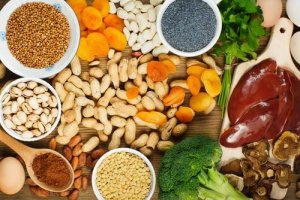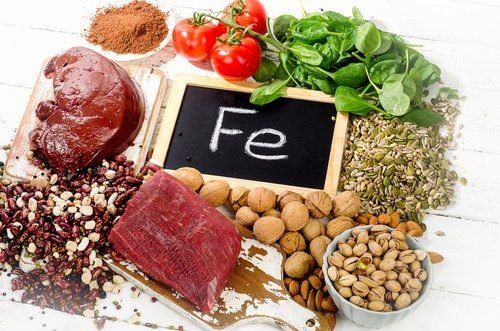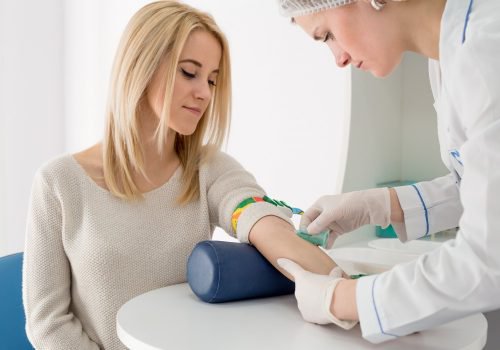Eat These Foods to Raise Your Levels of Iron


Written and verified by the pedagogue in physical education and nutritionist Elisa Morales Lupayante
Iron is a mineral that actively takes part in proper body functioning.
Among other functions, it’s present in the synthesis of DNA or in the formation of collagen. Besides, it increases your defenses to combat diseases and produce hormones and connective tissue.
Nevertheless, the principal task of iron is to transport and store oxygen.
Likewise, it participates in the process of cellular respiration to produce:
- Hemoglobin, a protein of the red blood cells that brings oxygen from the lungs to the rest of the body.
- Mioglobin, another similar protein, but with the facility to transport oxygen to the muscles.
Depending on the type of food that it is concentrated in, there are two types of iron:
- Heme. This iron is easy to absorb and found in animal products
- Non- heme. Absorbed in a very low quantity, this iron is found in foods of plant origin.
Read this article to learn more about how to raise your levels of iron.
What quantity of iron should you consume?
The body needs a certain quantity of iron according to the stage of life of each person. It also depends on diet, gender, and other factors.
In the following list are some of the most representative examples:
- Babies from 6 months to a year – .0000095 ounces
- Children from 4 to 8 years – .00035 ounces
- Adult men from 19 to 50 years – .00028
- Women from 19 to 50 – years – .00063
- Adolescents and pregnant women – .00095 ounces
- Lactating women – .00032
This interesting data reveals that adult and pregnant women need more than men. This is due to their body processes, such as menstruation.
Foods rich in iron

As mentioned above, iron is a mineral that is naturally found in foods both of animal and plant origin.
Below, we’ll make a list of foods that contain a considerable quantity of iron:
- Poultry (above all, the dark meat), eggs.
- Lean red meat, such as beef.
- Clams and other shellfish.
- Salmon
- Dried fruit: prunes, raisins, and dried apricot.
- Cereal and whole grained bread.
- Legumes: soybeans, lentils, dried beans, green beans, split peas, and fava beans.
- Vegetables: spinach, broccoli, cabbage, asparagos, dandelion greens, and kale.
- Whole grains: wheat, oats, brown rice.
It’s important to point out the absorption of iron from vegetables, fruit, grains and food supplements is less than that of meat.
In spite of this, the absorption of iron in vegetables can triple if combined with lean meat or legumes and dark leafy green vegetables.
Another way to help your body improve the absorption of iron is to consume foods with a high amount of vitamin C.
Vitamin C facilitates the uptake of iron at a gastrointestinal level.
Continue reading about iron: How to increase the levels of iron naturally
Do I need to consume more iron?
For those who are not in the medical or nutrition field, knowing the symptoms of low iron levels in the body can be a difficult task.
However, there are some signs and symptoms that allow you to identify that you need to raise your levels of iron.
Overall, low levels of iron can cause anemia. Anemia is a condition in which the body does not produce sufficient quantities of hemoglobin in the blood.
Symptoms of anemia or low levels of hemoglobin in the blood

- Paleness
- Out of breath when exercising
- Muscular fatigue
- Low levels of performance
- Neurological ailments: dizziness, headaches, and vertigo
- Kidney alterations: edema and swelling of legs
- Increased heart rate
Additionally, those with vegetarian diets need to consume twice the recommended daily quantity this mineral. This is because the absorption of vegetables is much less than when meat is consumed.
Read the following: 3 healthy recipes and foods to combat anemia
Risks of excess iron

Eating foods rich is iron is always positive when in a balanced diet and under the supervision of a physician. However, too much iron can present the following symptoms:
- Gastric problems
- Constipation
- Vomiting
In some cases, it can include failure of some body organs. As you can imagine, this is harmful. In the same way, excess consumption of iron can also cause illnesses. Some of these are breast cancer, cardiac irregularity, and cirrhosis of the liver.
As you’ve seen, it’s very important to check the levels of iron in your blood and body. The best way to do this is by means of a blood test.
At the same time, you can’t forget that the foundation for good health is a diverse and balanced diet.
All cited sources were thoroughly reviewed by our team to ensure their quality, reliability, currency, and validity. The bibliography of this article was considered reliable and of academic or scientific accuracy.
- National Institutes of Health. Office of Dietary Supplements. Hierro. Hoja informativa para consumidores. [Online] Available at: ods.od.nih.gov/factsheets/Iron-DatosEnEspanol/
- Forrellat Barrios M,Gautier du Défaix Gómez H, Fernández Delgado N. Metabolismo del hierro. Instituto de Hematología e Inmunología. Ciudad de la Habana. Rev Cubana Hematol Inmunol Hemoter 2000;16(3)
- Healthline.com Iron, Folate, and Other Essential Vitamins You’re Not Getting Enough of (and Really Should) [Online] Available at: www.healthline.com/health/vitamin-deficiency-in-women
- Rodrigo L. Hemocromatosis hereditaria. Rev. esp. enferm. dig. Madrid 2006;98(11)
- Muñoz Gómez M,Campos Garríguez A, García Erce JA, Ramírez Ramírez G. Fisiopatología del metabolismo del hierro: implicaciones diagnósticas y terapéuticas. NEFROLOGÍA. 2005;25(1)
This text is provided for informational purposes only and does not replace consultation with a professional. If in doubt, consult your specialist.








